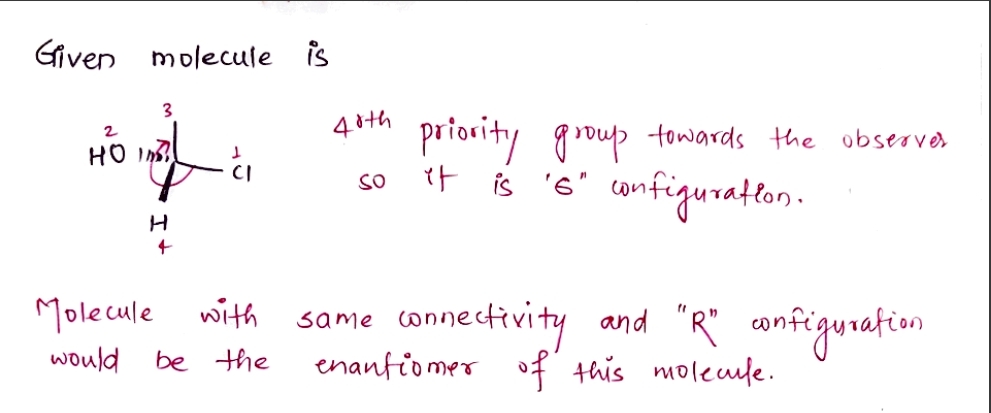Check the box under each structure in the table that is an enantiomer of the molecule shown below. If none of them are, check the none of the above box under he table. 10*** H HO CI Molecule 1 CI H H Molecule 4 OH CI HO Onone of the above Molecule 2 CI OH H Molecule 5 HO" H 0 CI Molecule 3 Br OH www H Molecule 6 CI 40 1014 HO "H X 5 C 0 C 9
Check the box under each structure in the table that is an enantiomer of the molecule shown below. If none of them are, check the none of the above box under he table. 10*** H HO CI Molecule 1 CI H H Molecule 4 OH CI HO Onone of the above Molecule 2 CI OH H Molecule 5 HO" H 0 CI Molecule 3 Br OH www H Molecule 6 CI 40 1014 HO "H X 5 C 0 C 9
Chemistry
10th Edition
ISBN:9781305957404
Author:Steven S. Zumdahl, Susan A. Zumdahl, Donald J. DeCoste
Publisher:Steven S. Zumdahl, Susan A. Zumdahl, Donald J. DeCoste
Chapter1: Chemical Foundations
Section: Chapter Questions
Problem 1RQ: Define and explain the differences between the following terms. a. law and theory b. theory and...
Related questions
Question
Check the box under each structure in the table that is an enantiomer of the molecule shown below. If none of them are, check the none of the above box under the table.

Transcribed Image Text:**Identifying the Enantiomer of a Chiral Molecule**
**Instructions:**
Check the box under each structure in the table that is an enantiomer of the molecule shown below. If none of them are, check the "none of the above" box under the table.
**Reference Molecule:**
- A central carbon with:
- Hydroxyl group (OH)
- Chlorine (Cl)
- Two hydrogens (H).
**Molecule Options:**
- **Molecule 1:**
- Central carbon attached to:
- Chlorine (Cl)
- Hydroxyl group (OH)
- Hydrogen (H)
- **Molecule 2:**
- Central carbon attached to:
- Chlorine (Cl)
- Hydroxyl group (OH)
- Hydrogen (H)
- **Molecule 3:**
- Central carbon attached to:
- Hydroxyl group (OH)
- Bromine (Br)
- Hydrogen (H)
- **Molecule 4:**
- Central carbon attached to:
- Chlorine (Cl)
- Hydrogen (H)
- Hydroxyl group (OH)
- **Molecule 5:**
- Central carbon attached to:
- Hydroxyl group (OH)
- Hydrogen (H)
- Chlorine (Cl)
- **Molecule 6:**
- Central carbon attached to:
- Chlorine (Cl)
- Hydroxyl group (OH)
- Hydrogen (H)
**Options Below the Table:**
- Check the boxes if the molecule is an enantiomer.
- An option for “none of the above” is provided.
(Note: No checkboxes are pre-selected in the image.)
**Additional Information:**
- **Enantiomers** are pairs of molecules that are mirror images of each other and cannot be superimposed onto one another. To identify enantiomers, compare the arrangement of groups around the chiral center in each molecule.
Expert Solution
Step 1: given

Step by step
Solved in 3 steps with 2 images

Knowledge Booster
Learn more about
Need a deep-dive on the concept behind this application? Look no further. Learn more about this topic, chemistry and related others by exploring similar questions and additional content below.Recommended textbooks for you

Chemistry
Chemistry
ISBN:
9781305957404
Author:
Steven S. Zumdahl, Susan A. Zumdahl, Donald J. DeCoste
Publisher:
Cengage Learning

Chemistry
Chemistry
ISBN:
9781259911156
Author:
Raymond Chang Dr., Jason Overby Professor
Publisher:
McGraw-Hill Education

Principles of Instrumental Analysis
Chemistry
ISBN:
9781305577213
Author:
Douglas A. Skoog, F. James Holler, Stanley R. Crouch
Publisher:
Cengage Learning

Chemistry
Chemistry
ISBN:
9781305957404
Author:
Steven S. Zumdahl, Susan A. Zumdahl, Donald J. DeCoste
Publisher:
Cengage Learning

Chemistry
Chemistry
ISBN:
9781259911156
Author:
Raymond Chang Dr., Jason Overby Professor
Publisher:
McGraw-Hill Education

Principles of Instrumental Analysis
Chemistry
ISBN:
9781305577213
Author:
Douglas A. Skoog, F. James Holler, Stanley R. Crouch
Publisher:
Cengage Learning

Organic Chemistry
Chemistry
ISBN:
9780078021558
Author:
Janice Gorzynski Smith Dr.
Publisher:
McGraw-Hill Education

Chemistry: Principles and Reactions
Chemistry
ISBN:
9781305079373
Author:
William L. Masterton, Cecile N. Hurley
Publisher:
Cengage Learning

Elementary Principles of Chemical Processes, Bind…
Chemistry
ISBN:
9781118431221
Author:
Richard M. Felder, Ronald W. Rousseau, Lisa G. Bullard
Publisher:
WILEY